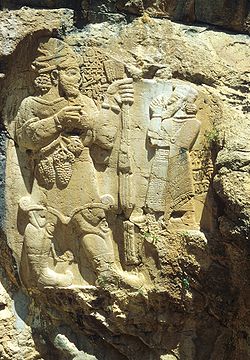Tarhunz / Tarhunt
Tarḫunz /Tarhunt (Nominative: Tarḫunz, Tarhunzas) was the weather god and chief god of the Luwians. Unlike Hittite Tarḫunna and Hurrian Teššub, his chariot was pulled by horses, not bulls. Usually, the weather god takes on clear traits of a fertility god, as in Late Luwian images showing Tarhunza with bunches of grapes and ears of grain. One of his epithets, piḫaššašši ("of the thunderbolt") was especially venerated in Tarḫuntašša, which was at one point the capital of the Hittite empire. Tarḫunt piḫaššašši was even chosen as the personal guardian god of King Muwatalli II. It is assumed that the Greek winged horse, Pegasus, which carried Zeus' thunderbolt, derives its name from this Luwian epithet. [3]
According to Late Luwian texts, Tarhunz gave the king royal power, courage, and marched before him in battle. He brought victory and conquests. In curse formulae, Tarhunz is called upon to "smash enemies with his axe." Often he is referred to as "Tarhunz of the Heavens". His most important cult centre was Aleppo, where a cult went back to the Bronze Age. The Hittite king Šuppiluliuma I had appointed his son Telipinu as priest and king of Aleppo.
As "Tarhunza of the vineyard" (Tarhunzas Tuwarsas), he was worshipped in Tabal. King Warpalawas of Tuwanuwa depicted him with ears of grain and bunches of grapes on the İvriz relief. Near the relief is a natural spring, which underlined the fertility aspect of the weather god. Cows and sheep were offered to him as sacrifices, in the hope that he would make the grain and the wine grow.
In late Luwian reliefs, Tarhunza is depicted as a bearded god with a short skirt and a helmet. In his right hand he bears an axe or a hammer and in his left hand he holds a bundle of thunderbolts. Often he is shown standing on a bull, like the Weather god of Aleppo [ de ].
Late Luwian inscriptions from Arslantepe also indicate local weather gods, of which nothing more is known than their names.
Other deities
Tiwad (Nom.: Tiwaz) was the Sun god. The Luwians had no female sun deity like the Hittite Sun goddess of Arinna. One of Tiwad's epithets was tati ("father"). The Late Luwian king Azatiwada ("Beloved of Tiwad") referred to him as "Tiwad of the Heavens".
Kamrušipa was the wife of Tiwad and mother of the guardian god Runtiya. She played an important role in magic rituals. In Late Luwian sources, she is not attested.
Arma was the moon god and appears in a large number of theophoric personal names (e.g. Armaziti, [4] "Man of Arma"), suggesting that he was a popular deity. In the Iron Age he completely merged with the moon god Sin of Harran and is often referred to in inscriptions as "Harranian Arma". He is depicted as a winged and bearded god with a crescent moon on his helmet. His name was written in Luwian hieroglyphs with a lunette. In curse formulae he is asked to "spear" the victim "with his horn."
Runtiya was a guardian god. His animal was the deer and his name was written in hieroglyphs with a deer's antlers. In Late Luwian texts, he is connected to the wilderness and serves as a god of the hunt. He is depicted as a god armed with bow and arrow, standing on a deer. His partner is the goddess Ala, who was identified with Kubaba in Kummuh.
Šanta /Santa was a death-bringing god, named along with the dark Marwainzi, as is Nikarawa in Late Luwian texts. This largely unknown deity was called upon in curses to feed an enemy to his dogs or to eat the enemy himself. Šanta was identified with the Babylonian god Marduk in the Bronze Age. His cult endured in Cilician Tarsos until classical antiquity where he was identified with Sandan-Herakles.
The goddess of fate Kwanza [ de ] and the plague god Iyarri are only attested indirectly in Late Luwian names. In the Bronze Age, the former was known as Gulza.


